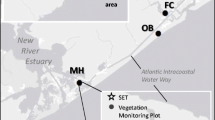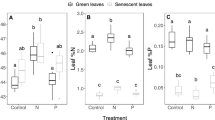Abstract
Nutrient availability is known to mediate plant community structure in many systems, but relatively few studies of nutrient effects have been done in systems where strong gradients in physical stress might constrain the effects of nutrients. Recent studies in New England, United States, salt marshes indicate that nutrients may strongly mediate plant community composition by increasing the competitive ability of stress-tolerant species that are normally displaced by competition to recently-disturbed or low-intertidal habitats. It is unknown whether these results can be generalized to salt marshes in other geographic regions that experience different climates, tidal regimes, and edaphic conditions. To address the generality of these results from New England, we fertilized seven different mixtures of salt marsh plants at study sites on the southeast and Gulf coasts of the U.S. Two of these mixtures were studied in both geographic regions. Consistent with results from New England, fertilization always increased the biomass of the low-marsh dominantSpartina alterniflora and usually led to it increasing in dominance at the expense of high-marsh species. Fertilization also led to increased community dominance byDistichlis, but only in a mixture where it was already common. Fertilization led to changes in plant dominance patterns in four of the seven types of mixtures that we studied. Results were not a function of edaphic conditions, at least within the range included in our study, and were consistent between the southeastern and Gulf coasts, which experience markedly different tidal regimes. The broad similarity of these results suggests that changes in nutrient input may lead to predictable changes in the composition of similar salt marsh plant communities across large geographic areas despite site to site variation in the abiotic environment.
Similar content being viewed by others
Literature Cited
Berendse, F. andW. T. Elberse. 1990. Competition and nutrient availability in heathland and grassland ecosystems, p. 93–116.In J. B. Grace and D. Tilman, (eds.). Perspectives on Plant Competition. Academic Press, San Diego, California.
Bertness, M. D. 1999. The Ecology of Atlantic Shorelines. Sinauer Associates, Inc., Sunderland, Massachusetts.
Bertness, M. D., P. J. Ewanchuk, andB. R. Silliman. 2002. Anthropogenic modification of New England salt marsh landscapes.Proceedings of the National Academy of Sciences 99:1395–1398.
Bertness, M. D. andS. D. Hacker. 1994. Physical stress and positive associations among marsh plants.American Naturalist 144:363–372.
Bertness, M. D. andS. W. Shumway. 1993. Competition and facilitation in marsh plants.American Naturalist 142:718–724.
Bobbink, R. 1991. Effects of nutrient enrichment in Dutch chalk grassland.Journal of Applied Ecology 28:28–41.
Chapman, V. J. 1960. Salt Marshes and Salt Deserts of the World. Leonard Hill Limited, London, U.K.
Covin, J. D. andJ. B. Zedler. 1988. Nitrogen effects onSpartina foliosa andSalicornia virginica in the salt marsh at Tijuana estuary, California.Wetlands 8:51–65.
Dunson, W. A. andJ. Travis. 1991. The role of abiotic factors in community organization.American Naturalist 138:1067–1091.
Emery, N. C., P. J. Ewanchuk, andM. D. Bertness. 2001. Competition and salt-marsh plant zonation: Stress tolerators may be dominant competitors.Ecology 82:2471–2485.
Gallagher, J. L. 1975. Effect of an ammonium nitrate pulse on the growth and elemental composition of natural stands ofSpartina alterniflora andJuncus roemerianus.American Journal of Botany 62:644–648.
Goldberg, D. E. andA. M. Barton. 1992. Patterns and consequences of interspecific competition in natural communities: A review of field experiments with plants.American Naturalist 139:771–801.
Hersh, D. A. 1996. Abundance and distribution of intertidal and subtidal macrophytes in Cape Cod: The role of nutrient supply and other controls. Ph.D. Dissertation, Boston University, Boston, Massachusetts.
Holligan, P. M. andW. A. Reiners 1992. Predicting the responses of the coastal zone to global change.Advances in Ecological Research 22:211–255.
Howarth, R. W. 1988. Nutrient limitation of net primary production in marine ecosystems.Annual Review of Ecology 19:89–110.
Jefferies, R. L. andN. Perkins. 1977. The effects on the vegetation of the addition of inorganic nutrients to salt marsh soils at Stiffkey, Norfolk.Journal of Ecology 65:867–882.
Levine, J. M., J. S. Brewer, andM. D. Bertness 1998. Nutrients, competition and plant zonation in a New England salt marsh.Journal of Ecology 86:285–292.
Nendelssohn, I. A. 1979. Nitrogen metabolism in the height forms ofSpartina alterniflora in North Carolina.Ecology 60: 574–584.
Mendelssohn, I. A., K. L. McKee, andD. T. Postek. 1982. Sublethal stresses controllingSpartina alterniflora productivity, p. 223–242.In B. Gopal, R. T. Turner, W. G. Wetzel, and D. F. Whigham (eds.). Wetlands: Ecology and Management. National Institute of Ecological International Scientific Publications, Jaipur, India.
Moloney, K. A. 1990. Shifting demographic control of a perennial bunchgrass along a natural habitat gradient.Ecology 71: 1133–1143.
Morris, J. T. 1991. Effects of nitrogen loading on wetland ecosystems with particular reference to atmospheric deposition.Annual Review of Ecology and Systematics 22:257–279.
Morris, J. T. andP. M. Bradley. 1999 Effects of nitrogen loading on the preservation of organic carbon in wetland sediments.Limnology and Oceanography 44:699–702.
Neilson, B. J. andL. E. Cronin. 1981. Estuaries and Nutrients. Humana Press, Clifton, New Jersey.
Nixon, S. W. 1995. Coastal marine eutrophication: A definition, social causes, and future concerns.Ophelia 41:199–219.
Nixon, S. W. 1997. Prehistoric nutrient inputs and productivity in Narragansett Bay.Estuaries 20:253–261.
Peierls, B. L., N. F. Caraco, M. L. Pace, andJ. J. Cole. 1991. Human influence on river nitrogen.Nature 350:386–387.
Pennings, S. C. andM. D. Bertness. 1999. Using latitudinal variation to examine effects of climate on coastal salt marsh pattern and process.Current Topics in Wetland Biogeochemistry 3:100–111.
Pennings, S. C. andM. D. Bertness. 2001. Salt marsh communities.In M. D. Bertness, S. D. Gaines, and M. E. Hay (eds.). Marine Community Ecology. Sinauer, Sunderland, Massachusetts.
Stiling, P., B. V. Brodbeck, andD. R. Strong. 1991. Population increases of planthoppers on fertilized salt-marsh cord grass may be prevented by grasshopper feeding.Florida Entomologist 74:88–97.
Stout, J. P. 1984. The ecology of irregularly flooded salt marshes of the northeastern Gulf of Mexico: A community profile. U.S. Fish and Wildlife Service Biological Report 85 (7.1). Washington, D.C.
Theodose, T. A. andW. D. Bowman. 1997. Nutrient availability, plant abundance, and species diversity in two alpine tundra communities.Ecology 78:1861–1872.
Tilman, D. 1987. Secondary succession and the pattern of plant dominance along experimental nitrogen gradients.Ecological Monographs 57:189–214.
Tilman, D. 1988. Plant Strategies and the Dynamics and Structure of Plant Communities. Princeton Monographs. Princeton, New Jersey.
Turner, R. E. 1976. Geographic variations in salt marsh macrophyte production: A review.Contributions in Marine Science 20:47–68.
Turner, R. E. andN. N. Rabalais. 1991. Changes in Mississippi River water quality in this century.BioScience 41:140–147.
Valiela, I., G. Collins, J. Kremer, K. Lajtha, M. Giest, B. Seely, J. Brawley, andC. H. Sham. 1997. Nitrogen loading from coastal watersheds to receiving estuaries: New method and application.Ecological Applications 7:358–380.
Valiela, I., K. Foreman, M. LaMontagne, D. Hersh, J. Costa, P. Peckol, B. DeMeo-Andreson, C. D'Avanzo, M. Babione, C.-H. Sham, J. Brawley, andK. Lajtha. 1992. Couplings of watersheds and coastal waters: Sources and consequences of nutrient enrichment in Waquoit Bay, Massachusetts.Estuaries 15:443–457.
Valiela, I. andJ. M. Teal. 1974. Nutrient limitation in salt marsh vegetation, p. 547–563.In R. J. Reimold and W. H. Queen (eds.). Ecology of Halophytes. Academic Press, New York.
Valiela, I., J. M. Teal, C. Cogswell, J. Hartman, S. Allen, R. Van Etten, andD. Goehringer. 1985. Some long-term consequences of sewage contamination in salt marsh ecosystems. p. 301–316.In P. J. Godfrey, E. R. Kaynor, S. Pelezarski, and J. Benforado (eds.). Ecological Considerations in Wetlands Treatment of Municipal Wastewaters. Van Nostrand Reinhold Co., New York.
Valiela, I., J. M. Teal, andW. G. Deuser. 1978. The nature of growth forms in the salt marsh grassSpartina alterniflora.American Naturalist 112:461–470.
Van Wijnen, H. andJ. P. Bakker. 1999. Nitrogen and phosphorus limitation in a coastal barrier salt marsh: The implications for vegetation succession.Journal of Ecology 87:265–272.
Vitousek, P. M. 1994. Beyond global warming: Ecology and global change.Ecology 75:1861–1876.
Wiegert, R. G. and B. J. Freeman. 1990. Tidal salt marshes of the southeast Atlantic coast: A community profile. U.S. Fish and Wildlife Service Biological Report 85(7.29). Washington, D.C.
Wisheu, I. C., P. A. Keddy, D. R. J. Moore, S. J. McCanny, andC. L. Gaudet. 1991. Effects of eutrophication on wetland vegetation.In J. Kusler and R. Smardon (eds.). Wetlands of the Great Lakes (Protection and Restoration Policies: Status of the Science). Proceedings of an International Symposium, Niagra Falls, New York, May 16–18, 1990. Managers Inc., New York.
Author information
Authors and Affiliations
Corresponding author
Rights and permissions
About this article
Cite this article
Pennings, S.C., Stanton, L.E. & Stephen Brewer, J. Nutrient effects on the composition of salt marsh plant communities along the Southern Atlantic and gulf coasts of the United States. Estuaries 25, 1164–1173 (2002). https://doi.org/10.1007/BF02692213
Received:
Accepted:
Issue Date:
DOI: https://doi.org/10.1007/BF02692213




